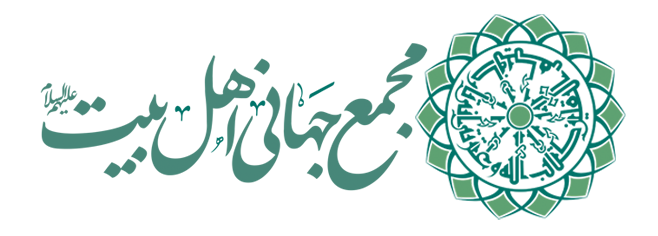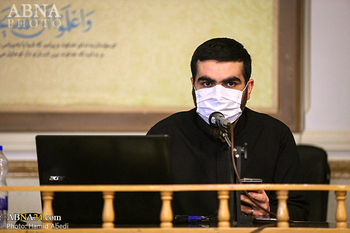Poetry, Literature Committee of Hazrat Abu Talib Conference/Citation of Lamia ode in Arabic literature
“Hazrat Abu Talib (a.s.) has a special position in Arabic literature and one of the gaps in this field is the lack of study of his poetry in the eyes of writers,” said the researcher of religious sciences.
The 3rd meeting of the International Conference of Hazrat Abu Talib (a.s.), the Supporter of the Grea Prophet (p.b.u.h), entitled the Committee of Poetry and Literature was held on Tuesday evening, March 9, 2021, in Shahid Sadr Hall in Imam Khomeini Higher Education Complex.
The chairman of the committee was Ayatollah Mohammad Saeed Nomani, the judge was Dr. Baqer Ghorbani Zarrin, a member of the faculty of Islamic Azad University Central Tehran Branch, and its secretary was Hojat al-Islam Valiullah Madanipour.
Deputy Secretary-General and Deputy of Cultural Affairs of the AhlulBayt (a.s.) World Assembly, Hojat al-Islam “Ahmad Ahmadi Tabar, and the Director-General of Research of the Assembly, Hojat al-Islam “Sayed Mohammad Reza Al-e Ayub” were also present in this committee.
“In this article, we have collected citations from Lamia ode in important Arabic books. This should be done for all the poems of Abu Talib (a.s.),” said Ahmad Bararian at the beginning of the committee, referring to his article entitled “Citations to the Lamia Ode of Abu Talib in Arabic Literature”.
“Although our work on collecting citations was limited to the Lamia ode, we followed the four branches of grammar, syntax, rhetoric, and vocabulary, and the article “Citations to the Lamia Ode of Abu Talib in Arabic Literature” was the result of my joint work with Mr. Sayed Muhammad Ali. Hashemi. The writing of this article took 150 hours, part of which was spent on preliminary studies. To write the article, we studied the Divan of Abu Talib (a.s.) and other works appropriate to the subject of the article,” he continued.
“For the article “Citations to the Lamia Ode of Abu Talib in Arabic Literature”, we looked at more than 50 sources, including the book “Al-Ayn”, the book “Asas Al-Balagha”, and the book “Sharh Al-Nezam”. The resources of this article were not limited in time and we brought out the leading books from prominent authors in the article. The article was organized in 6680 words in 9 sections,” added the researcher of the religious sciences.
“Imam Sadegh (a.s.) said in a Hadith, “Learn the poetry of Abu Talib and teach it to your children.” This narration shows the position of the poetry of Hazrat Abu Talib (a.s.) in the eyes of the AhlulBayt (a.s.), and this is one of our motivations for entering into this field. This is a step towards raising the name of Hazrat Abu Talib (a.s.). We also had a scientific motivation for our work. Hazrat Abu Talib (a.s.) has a special place in Arabic literature,” Bararian stated, referring to the motivation and purpose of writing the article “Citations to the Lamia Ode of Abu Talib in Arabic Literature”.
“The scientific aspects of the personality of Hazrat Abu Talib (a.s.) have received less attention than they should. One of the gaps in this field is the study of the position of the poetry of Abu Talib (a.s.) in the eyes of writers. We seek to explain the position of his poetry,” he continued.
Abu Talib’s poetry in Arabic literature, examples of syntax, examples of morphology, examples of vocabulary, and examples of rhetoric, are among the various sections of the article “Citations to the Lamia Ode of Abu Talib in Arabic Literature”,” added the researcher of religious sciences.
“The position of Abu Talib (a.s.) poetry is neglected among the writers. The question must be answered whether the literary aspects of the poetry of Hazrat Abu Talib (a.s.) are accepted by prominent writers or not,” he mentioned.
“This character is oppressed and many people have not mentioned his literary aspects. But the literary aspects of Hazrat Abu Talib (a.s.) were so prominent that it seems to have imposed itself on the writers and some prominent writers such as Zamakhshari were forced to cite the ode of Lamia of Hazrat Abu Talib (a.s.),” Ayatollah Nomani stated, referring to the oppression of Hazrat Abu Talib (a.s.).
“In historical books, genealogy and Rijals have referred to the poems of Hazrat Abu Talib (a.s.). The citation of his poems is not limited to literary books. This is due to the high position of his literature. It is necessary to collect citations to the poems of Hazrat Abu Talib (a.s.) in different books and prepare articles in this regard,” Baqer Ghorban Zarrin also said in the following in the committee.
It should be mentioned that by the initiation of the AhlulBayt (a.s.) World Assembly, and support and cooperation of the similar institutions, including, “Imam Hossein (a.s.) Holy Shrine”, “Hazrat Aboutaleb Research and Publishing Institute”, “The World Forum for Proximity of Islamic Schools of Thought”, “Islamic Sciences and Culture Academy of Islamic Propagation Office”, “Al-Mustafa International University”, “Hawza Language teaching center”, “International University of AhlulBayt (a.s.)”, “Mirath-e Nabowat Cultural Institute”, “Jamiat al-Zahra Seminary University”, “Zorria al-Nabawia Research Center”, “Qasem ibn al-Hassan (a.s.) Religious-Cultural Institute”, and “Abna al-Rasoul Cultural and Artistic Institute”; international conference “Hazrat Abu Talib (a.s.), Supporter of the Great Prophet (p.b.u.h)” will be held on Rajab 25, 26 and 27, 1442 (March 9, 10 and 11, 2021) on the anniversary of the death of Abu Talib (a.s.).
The deadline for submitting academic works and articles to this conference has been extended until February 18, 2021.
To receive the academic call of the conference, click here.
The other program which will be held on the sideline of the conference is the “General Festival of Poetry about Hazrat Abu Talib (a.s.)”.
To receive the academic call for the Poetry Festival, click here.
“Hazrat Abu Talib (a.s.) has a special position in Arabic literature and one of the gaps in this field is the lack of study of his poetry in the eyes of writers,” said the researcher of religious sciences.
The 3rd meeting of the International Conference of Hazrat Abu Talib (a.s.), the Supporter of the Grea Prophet (p.b.u.h), entitled the Committee of Poetry and Literature was held on Tuesday evening, March 9, 2021, in Shahid Sadr Hall in Imam Khomeini Higher Education Complex.
The chairman of the committee was Ayatollah Mohammad Saeed Nomani, the judge was Dr. Baqer Ghorbani Zarrin, a member of the faculty of Islamic Azad University Central Tehran Branch, and its secretary was Hojat al-Islam Valiullah Madanipour.
Deputy Secretary-General and Deputy of Cultural Affairs of the AhlulBayt (a.s.) World Assembly, Hojat al-Islam “Ahmad Ahmadi Tabar, and the Director-General of Research of the Assembly, Hojat al-Islam “Sayed Mohammad Reza Al-e Ayub” were also present in this committee.
“In this article, we have collected citations from Lamia ode in important Arabic books. This should be done for all the poems of Abu Talib (a.s.),” said Ahmad Bararian at the beginning of the committee, referring to his article entitled “Citations to the Lamia Ode of Abu Talib in Arabic Literature”.
“Although our work on collecting citations was limited to the Lamia ode, we followed the four branches of grammar, syntax, rhetoric, and vocabulary, and the article “Citations to the Lamia Ode of Abu Talib in Arabic Literature” was the result of my joint work with Mr. Sayed Muhammad Ali. Hashemi. The writing of this article took 150 hours, part of which was spent on preliminary studies. To write the article, we studied the Divan of Abu Talib (a.s.) and other works appropriate to the subject of the article,” he continued.
“For the article “Citations to the Lamia Ode of Abu Talib in Arabic Literature”, we looked at more than 50 sources, including the book “Al-Ayn”, the book “Asas Al-Balagha”, and the book “Sharh Al-Nezam”. The resources of this article were not limited in time and we brought out the leading books from prominent authors in the article. The article was organized in 6680 words in 9 sections,” added the researcher of the religious sciences.
“Imam Sadegh (a.s.) said in a Hadith, “Learn the poetry of Abu Talib and teach it to your children.” This narration shows the position of the poetry of Hazrat Abu Talib (a.s.) in the eyes of the AhlulBayt (a.s.), and this is one of our motivations for entering into this field. This is a step towards raising the name of Hazrat Abu Talib (a.s.). We also had a scientific motivation for our work. Hazrat Abu Talib (a.s.) has a special place in Arabic literature,” Bararian stated, referring to the motivation and purpose of writing the article “Citations to the Lamia Ode of Abu Talib in Arabic Literature”.
“The scientific aspects of the personality of Hazrat Abu Talib (a.s.) have received less attention than they should. One of the gaps in this field is the study of the position of the poetry of Abu Talib (a.s.) in the eyes of writers. We seek to explain the position of his poetry,” he continued.
Abu Talib’s poetry in Arabic literature, examples of syntax, examples of morphology, examples of vocabulary, and examples of rhetoric, are among the various sections of the article “Citations to the Lamia Ode of Abu Talib in Arabic Literature”,” added the researcher of religious sciences.
“The position of Abu Talib (a.s.) poetry is neglected among the writers. The question must be answered whether the literary aspects of the poetry of Hazrat Abu Talib (a.s.) are accepted by prominent writers or not,” he mentioned.
“This character is oppressed and many people have not mentioned his literary aspects. But the literary aspects of Hazrat Abu Talib (a.s.) were so prominent that it seems to have imposed itself on the writers and some prominent writers such as Zamakhshari were forced to cite the ode of Lamia of Hazrat Abu Talib (a.s.),” Ayatollah Nomani stated, referring to the oppression of Hazrat Abu Talib (a.s.).
“In historical books, genealogy and Rijals have referred to the poems of Hazrat Abu Talib (a.s.). The citation of his poems is not limited to literary books. This is due to the high position of his literature. It is necessary to collect citations to the poems of Hazrat Abu Talib (a.s.) in different books and prepare articles in this regard,” Baqer Ghorban Zarrin also said in the following in the committee.
It should be mentioned that by the initiation of the AhlulBayt (a.s.) World Assembly, and support and cooperation of the similar institutions, including, “Imam Hossein (a.s.) Holy Shrine”, “Hazrat Aboutaleb Research and Publishing Institute”, “The World Forum for Proximity of Islamic Schools of Thought”, “Islamic Sciences and Culture Academy of Islamic Propagation Office”, “Al-Mustafa International University”, “Hawza Language teaching center”, “International University of AhlulBayt (a.s.)”, “Mirath-e Nabowat Cultural Institute”, “Jamiat al-Zahra Seminary University”, “Zorria al-Nabawia Research Center”, “Qasem ibn al-Hassan (a.s.) Religious-Cultural Institute”, and “Abna al-Rasoul Cultural and Artistic Institute”; international conference “Hazrat Abu Talib (a.s.), Supporter of the Great Prophet (p.b.u.h)” will be held on Rajab 25, 26 and 27, 1442 (March 9, 10 and 11, 2021) on the anniversary of the death of Abu Talib (a.s.).
The deadline for submitting academic works and articles to this conference has been extended until February 18, 2021.
To receive the academic call of the conference, click here.
The other program which will be held on the sideline of the conference is the “General Festival of Poetry about Hazrat Abu Talib (a.s.)”.
To receive the academic call for the Poetry Festival, click here.






